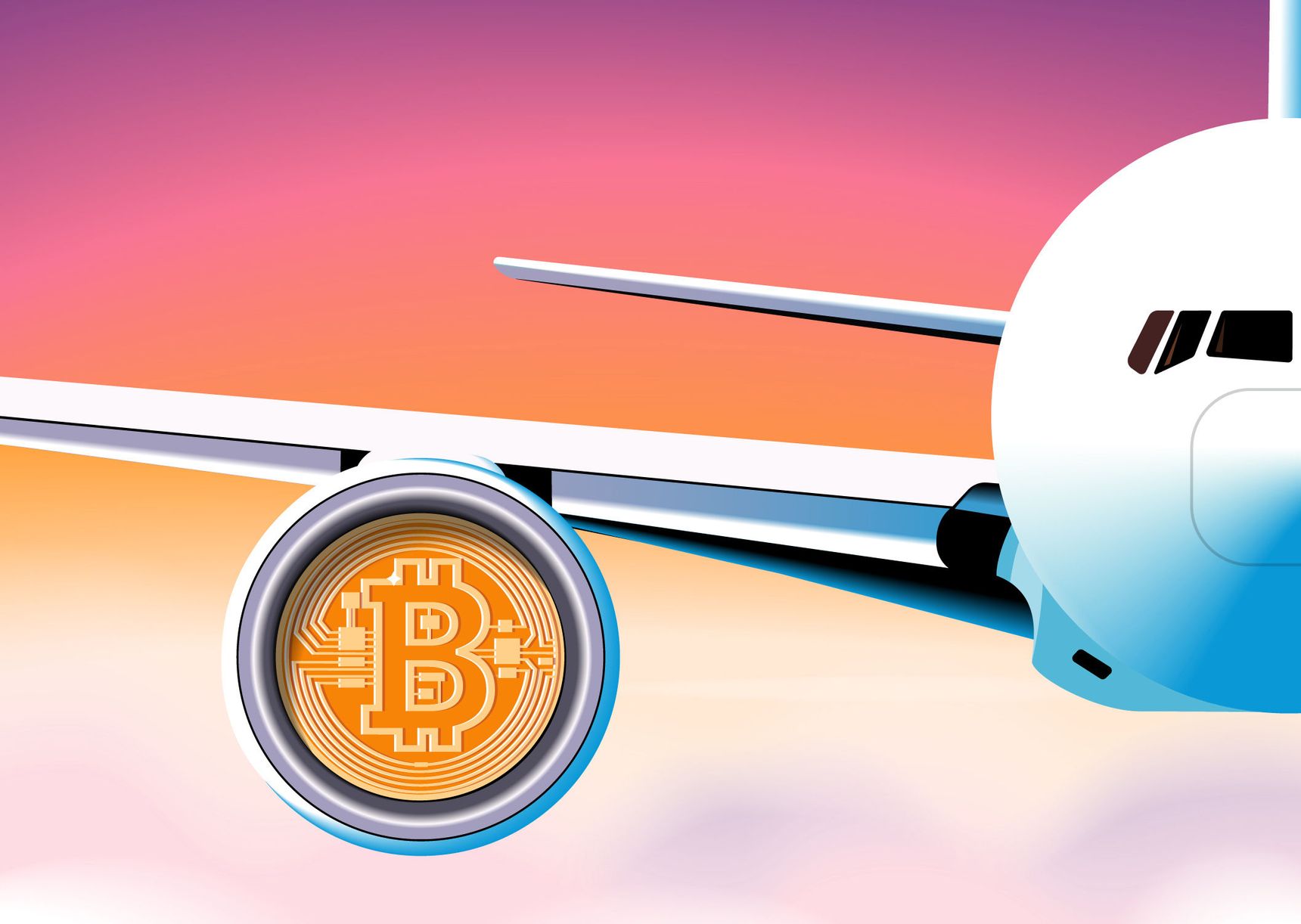Have Bitcoin, Will Travel? 4 Strategies for Crypto-Holidays
A host of companies–including luxury ski resorts and at least one surf town—let you pay for R&R services with digital cash.
MAYBE YOU’RE still flush with crypto cash. Or perhaps your Bitcoin portfolio is hemorrhaging value amid the recent turbulence. Either way, if turning digital assets into rest and relaxation sounds appealing, you have options. Marko Jovic, a 41-year-old telecom engineer from Belgrade, Serbia, began using crypto to pay for vacations in 2021. He said despite a recent fall in value he can pay for a lot of things with his crypto. “You can basically do anything you want with crypto,” said Mr. Jovic.
Now that you can get debit cards linked to cryptocurrency portfolios, it’s never been easier to use digital cash while on the move. But for travelers who want to avoid the extra fees associated with using a crypto card, the alternative is to seek out merchants willing to accept cryptocurrency like Bitcoin directly. Luckily, a growing list of companies, hotels and destinations are eager to do business with crypto consumers. Here, a few up-to-the-minute moves:
1. Book a trip via an online travel agency
Travala.com has emerged as the leader among the handful of online booking sites that accept crypto. It may offer fewer routes and destinations than traditional air-travel sites do and sometimes list slightly higher prices, said Mr. Jovic, who recently used it to book a flight to Budapest, but he finds the ability to pay with crypto outweighs those factors. While Travala co-founder and CEO Juan Otero, who worked at Booking.com in the late 2000s, agrees his company needs to be more competitive on airfare, he argues that its luxury hotel offerings compare well to rivals’. Of Travala’s monthly active users, Mr. Otero said, an-above average number opt for “four- and five-star hotels.” Omar Hamwi, a 37-year-old crypto professional from Washington, D.C., and self-described loyal customer of Travala, booked a stay most recently at the five-star Fairmont Orchid in Hawaii. “I have idle crypto so I generally do like to use it when I can,” he said.
2. Buy a flight ticket directly with the airline
You can book flights directly with at least one crypto-friendly airline—AirBaltic, Latvia’s premier carrier which services more than 70 destinations, primarily in the Baltics and Europe—but if you’re not flying out of Riga, it may be hard to take advantage. Still, according to the airline, since it began accepting crypto back in 2014, more than 1,000 customers have purchased tickets that way.
3. Reserve a swanky hotel
The Chedi, a chic luxury resort in the Swiss Alps lets guests pay with Bitcoin or Ethereum, as long as they’re spending more than $200 when paying for rooms or services like ski rentals and spa days—easily done since room rates generally start at $650 a night. The Pavilions Hotels & Resorts, a boutique hotel group with locations in Europe and Asia including Rome, Amsterdam, Bali and Phuket, also accepts cryptocurrency bookings. For travelers who prefer to spend their crypto gains stateside, there’s the Kessler Collection, whose portfolio include several hotels in the southern U.S., as well as a ski lodge in Beaver Creek, Colo.
4. Visit a ‘cryptopia’
If anything close to a crypto Utopia exists, it’s the surf town of El Zonte, El Salvador, otherwise known as “Bitcoin Beach.” There, travelers can grub on pupusas after a day of surf lessons at El Zonte’s point break, and pay for it all with Bitcoin. “Most of the merchants accept Bitcoin,” said Carol Souza, a Brazilian influencer focused on educating people about crypto. Other cities are expected to follow suit. Earlier this month, the small picturesque city of Lugano, Switzerland, announced it is also adopting cryptocurrency as legal tender.
Reprinted by permission of The Wall Street Journal, Copyright 2021 Dow Jones & Company. Inc. All Rights Reserved Worldwide. Original date of publication: 28 March 2022.
This stylish family home combines a classic palette and finishes with a flexible floorplan
Just 55 minutes from Sydney, make this your creative getaway located in the majestic Hawkesbury region.
As Paris makes its final preparations for the Olympic games, its residents are busy with their own—packing their suitcases, confirming their reservations, and getting out of town.
Worried about the hordes of crowds and overall chaos the Olympics could bring, Parisians are fleeing the city in droves and inundating resort cities around the country. Hotels and holiday rentals in some of France’s most popular vacation destinations—from the French Riviera in the south to the beaches of Normandy in the north—say they are expecting massive crowds this year in advance of the Olympics. The games will run from July 26-Aug. 1.
“It’s already a major holiday season for us, and beyond that, we have the Olympics,” says Stéphane Personeni, general manager of the Lily of the Valley hotel in Saint Tropez. “People began booking early this year.”
Personeni’s hotel typically has no issues filling its rooms each summer—by May of each year, the luxury hotel typically finds itself completely booked out for the months of July and August. But this year, the 53-room hotel began filling up for summer reservations in February.
“We told our regular guests that everything—hotels, apartments, villas—are going to be hard to find this summer,” Personeni says. His neighbours around Saint Tropez say they’re similarly booked up.
As of March, the online marketplace Gens de Confiance (“Trusted People”), saw a 50% increase in reservations from Parisians seeking vacation rentals outside the capital during the Olympics.
Already, August is a popular vacation time for the French. With a minimum of five weeks of vacation mandated by law, many decide to take the entire month off, renting out villas in beachside destinations for longer periods.
But beyond the typical August travel, the Olympics are having a real impact, says Bertille Marchal, a spokesperson for Gens de Confiance.
“We’ve seen nearly three times more reservations for the dates of the Olympics than the following two weeks,” Marchal says. “The increase is definitely linked to the Olympic Games.”

Getty Images
According to the site, the most sought-out vacation destinations are Morbihan and Loire-Atlantique, a seaside region in the northwest; le Var, a coastal area within the southeast of France along the Côte d’Azur; and the island of Corsica in the Mediterranean.
Meanwhile, the Olympics haven’t necessarily been a boon to foreign tourism in the country. Many tourists who might have otherwise come to France are avoiding it this year in favour of other European capitals. In Paris, demand for stays at high-end hotels has collapsed, with bookings down 50% in July compared to last year, according to UMIH Prestige, which represents hotels charging at least €800 ($865) a night for rooms.
Earlier this year, high-end restaurants and concierges said the Olympics might even be an opportunity to score a hard-get-seat at the city’s fine dining.
In the Occitanie region in southwest France, the overall number of reservations this summer hasn’t changed much from last year, says Vincent Gare, president of the regional tourism committee there.
“But looking further at the numbers, we do see an increase in the clientele coming from the Paris region,” Gare told Le Figaro, noting that the increase in reservations has fallen directly on the dates of the Olympic games.
Michel Barré, a retiree living in Paris’s Le Marais neighbourhood, is one of those opting for the beach rather than the opening ceremony. In January, he booked a stay in Normandy for two weeks.
“Even though it’s a major European capital, Paris is still a small city—it’s a massive effort to host all of these events,” Barré says. “The Olympics are going to be a mess.”
More than anything, he just wants some calm after an event-filled summer in Paris, which just before the Olympics experienced the drama of a snap election called by Macron.
“It’s been a hectic summer here,” he says.

AFP via Getty Images
Parisians—Barré included—feel that the city, by over-catering to its tourists, is driving out many residents.
Parts of the Seine—usually one of the most popular summertime hangout spots —have been closed off for weeks as the city installs bleachers and Olympics signage. In certain neighbourhoods, residents will need to scan a QR code with police to access their own apartments. And from the Olympics to Sept. 8, Paris is nearly doubling the price of transit tickets from €2.15 to €4 per ride.
The city’s clear willingness to capitalise on its tourists has motivated some residents to do the same. In March, the number of active Airbnb listings in Paris reached an all-time high as hosts rushed to list their apartments. Listings grew 40% from the same time last year, according to the company.
With their regular clients taking off, Parisian restaurants and merchants are complaining that business is down.
“Are there any Parisians left in Paris?” Alaine Fontaine, president of the restaurant industry association, told the radio station Franceinfo on Sunday. “For the last three weeks, there haven’t been any here.”
Still, for all the talk of those leaving, there are plenty who have decided to stick around.
Jay Swanson, an American expat and YouTuber, can’t imagine leaving during the Olympics—he secured his tickets to see ping pong and volleyball last year. He’s also less concerned about the crowds and road closures than others, having just put together a series of videos explaining how to navigate Paris during the games.
“It’s been 100 years since the Games came to Paris; when else will we get a chance to host the world like this?” Swanson says. “So many Parisians are leaving and tourism is down, so not only will it be quiet but the only people left will be here for a party.”
This stylish family home combines a classic palette and finishes with a flexible floorplan
Just 55 minutes from Sydney, make this your creative getaway located in the majestic Hawkesbury region.


















